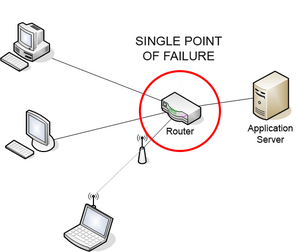Single point of failure facts for kids
A single point of failure (often called SPOF) is like a single weak link in a chain. If this one part of a system breaks down, the entire system stops working. Imagine a game console that needs a special power cord. If that one cord breaks, you can't play the game, even if the console itself is fine. That power cord is a single point of failure.
Engineers and designers try to avoid single points of failure when they build important systems. They want to make sure things keep working, even if one part has a problem. This is called making a system more reliable or having high availability.
To avoid a single point of failure, they often add redundancy. This means having more than one way for something to work, or more than one part that can do the same job. If one part fails, another can take over.
Contents
What is a Single Point of Failure?
A single point of failure is any part of a system that, if it fails, causes the entire system to stop functioning. Think of it as the only path to a goal. If that path is blocked, you can't reach the goal.
Why are SPOFs bad?
Single points of failure are bad because they make systems unreliable. If something important relies on just one component, and that component breaks, everything stops. This can lead to big problems, like a website going offline, a factory stopping production, or even a city losing power.
Examples of SPOFs
- A single bridge to an island: If there's only one bridge connecting an island to the mainland, and that bridge collapses, no one can get on or off the island by car. The bridge is a single point of failure for land travel.
- One power plant for a city: If a city gets all its electricity from just one power plant, and that plant shuts down, the whole city loses power.
- A single server for a website: If a website runs on only one computer server, and that server crashes, the website will become unavailable for everyone.
- One network cable: If a computer needs a specific network cable to connect to the internet, and that cable gets cut, the computer loses its internet connection.
How to Avoid Single Points of Failure
To make systems more reliable, engineers use different strategies to avoid single points of failure. The main idea is to add redundancy, meaning having backups or multiple ways for things to work.
Adding Redundancy
Redundancy means having extra parts or paths so that if one fails, another can take its place.
Backup Systems
- Extra power supplies: Important computers often have two or more power cords plugged into different power sources. If one power source fails, the computer keeps running on the other.
- Backup servers: Websites often use many servers. If one server goes down, other servers can immediately take over its work, so users don't even notice a problem.
- Spare parts: Factories might keep extra parts for their machines. If a part breaks, they can quickly replace it and keep working.
Multiple Paths
- More than one road: A city might have several roads leading to a key area. If one road is closed for repairs or an accident, traffic can still use the other roads.
- Multiple network connections: Large buildings or data centers often have several internet connections from different providers. If one connection goes down, they can still access the internet through another.
Load Balancing
Load balancing is a way to spread work across multiple components. Instead of one server doing all the work, a "load balancer" directs incoming requests to several servers. If one server gets too busy or fails, the load balancer sends requests to the other available servers. This makes the system faster and more reliable.
RAID for Storage
RAID (Redundant Array of Independent Disks) is a technology used for computer storage. It combines multiple hard drives into one logical unit. If one hard drive fails, the data can still be accessed from the other drives, preventing data loss and system downtime.
Benefits of Avoiding SPOFs
By avoiding single points of failure, systems become much more robust and dependable.
Increased Reliability
A reliable system is one that works consistently and correctly when you need it. By removing single points of failure, the chances of the entire system breaking down are greatly reduced. This is important for things like emergency services, banking systems, and communication networks.
High Availability
High availability means a system is available and working almost all the time. Systems designed to avoid single points of failure can continue operating even when parts fail. This is crucial for online services that need to be accessible 24/7, like social media platforms or online stores.
See also
 In Spanish: Punto único de fallo para niños
In Spanish: Punto único de fallo para niños


